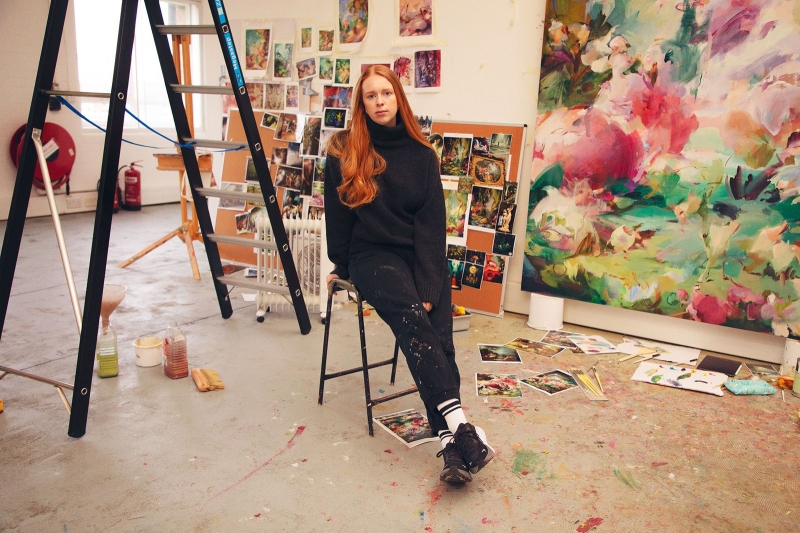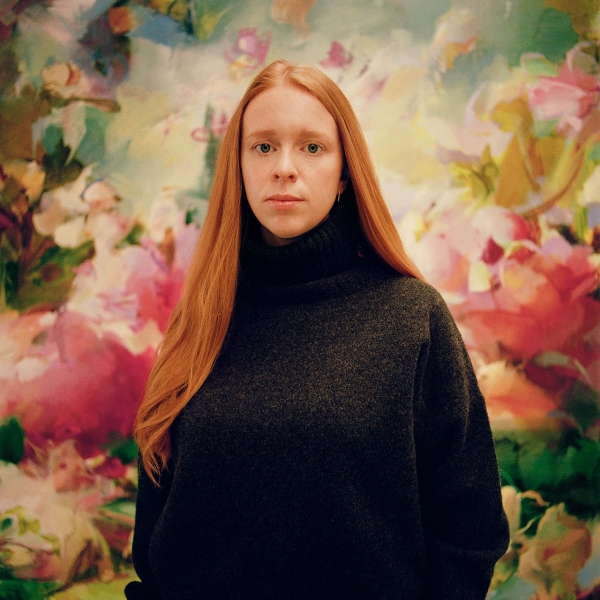On an otherwise unremarkable day in the spring of 2017, Flora Yukhnovich, a 27-year-old master of fine art student with no distinct technique, no discernible profile, and no particular prospects, climbed the Wallace Collection’s grand marble staircase and came down again, an hour or so later, fixed on the aesthetic that would make her the pre-eminent British painter of her generation. There, in among the Gouthière clocks and Jean Ducrollay snuffboxes, she’d come face-to-face with Jean-Honoré Fragonard’s The Swing, the inescapable French fancy that distills the 18th-century rococo movement’s frivolity and flirtatiousness into a titillating trio of figures: a Marie Antoinette-esque coquette, suspended aloft in billowing blush-silk skirts; her bewigged, cuckolded husband, lurking in the shadows of an Arcadian forest; and her ancien régime paramour, reaching for her as she suggestively sends a ballet-pink slipper flying towards him in the velvet undergrowth.
“It felt like all these strands that I’d been looking at came together,” Yukhnovich tells me today of the 25-by-31-inch canvas, which has, in the centuries since a licentious French baron commissioned it, been reproduced everywhere from Disney’s Frozen to a fridge magnet on Etsy. She’s perching on a rickety folding stool in her southeast London studio, her head tilted in a way that brings out her own resemblance to one of Fragonard’s subjects: copper hair, heart-shaped face, ivory skin, Cupid’s-bow lips. Until that point, she says, she’d spent her MFA indulging her “light-hearted curiosity” about the froufrou via Spode’s Blue Italian porcelain and aughts Cath Kidston wallpapers, and feeling vaguely ashamed about it. (Tricky to imagine her teen idols, Lucian Freud and Frank Auerbach, studying Sèvres’s elephant-head vases with any degree of seriousness.) But with The Swing in her mind’s eye, she suddenly “got the bit between my teeth”—and began to query how and why decorative had come to mean downmarket, the ladylike inherently lowbrow.
Four years later, Tu Vas me Faire Rougir (You’re Going to Make me Blush)—one of three Permanent Rose-daubed reinterpretations of Fragonard she painted for her graduate show—sold at Christie’s for £1,902,000, making her, in the space of a gavel stroke, a bonafide blue-chip artist. Gradually, she expanded her remit beyond Fragonard to encompass other rococo masterpieces—Giovanni Battista Tiepolo’s celestial allegories, Nicolas Lancret’s rural idylls—exposing the ways in which they had shaped fashionable conceptions of the “coded feminine,” both then and now. See 2020’s Warm, Wet N’ Wild, which repositions Katy Perry’s maraschino-topped “California Gurls” video in the fruity, fecund context of Watteau’s fête galantes. It sold to a private collector, by way of Sotheby’s, for £2,697,000 in 2022.

The press demanded to know why a 30-something’s works—part figurative, part abstract, wholly millennial—were suddenly going for something like 30 times their estimates. How could the lilac-and violet-flecked Imagination, Life Is Your Creation be hanging in Rishi Sunak’s Downing Street home without anyone knowing the origin story of its “Barbie Girl”-obsessed creator? And what did it say about the market that her riffs on the frothiest, most fatuous period in Western art history were fetching more than the Old Masters she was imitating? “It is an extraordinary thing,” says Sotheby’s contemporary art specialist Emma Baker, who orchestrated the auctioning of Warm, Wet N’ Wild several months before Jean-François de Troy’s The Reading Party (1735) went for roughly the same price at Christie’s. (Should you wish to see other entries in De Troy’s tableaux de mode series, you can find them, in positions of prominence, at The Met and in The V&A.) “She absolutely has set records.”
By way of response, Yukhnovich has done nothing so much as retreat: holing up in her aerie-like workspace south of the Thames, five stories above a confluence of Tube lines, her only company the seagulls that periodically land on her skylight. “I like to look at the work and think about the work,” she says. “I’m not that interested in having to reflect the work through the self as well.” This isn’t, I come to realize, pure deflection; the 34-year-old’s approach to her creations verges on solipsistic, in the philosophical sense. When Victoria Miro, the fairy godmother of Britart, dropped by with a view to representing her in 2019, she spent the gallerist’s visit wracked with nerves—not about whether she would join Chris Ofili and Yayoi Kusama on her roster, but about the placement of an acanthus leaf in one of her own canvases. (Miro signed her in 2021, with Hauser & Wirth co-representing her from 2023 onwards.)
Said studio sprawls across the top floor of a converted Victorian biscuit factory that, in the 1800s, churned out custard creams and bourbons by the millions each year. Today, in lieu of actual sugar, its floors are strewn with saccharine imagery in preparation for her own installation at the Wallace Collection this June: a response to François Boucher’s 1749 pastorals ne plus ultra, With a Bagpipe Player and With a Couple Near a Fountain. To see them reimagined by Yukhnovich will represent a turning point for both the artist and the Marylebone institution, home to two centuries’ worth of Limoges enamel and Louis XIV furniture collected by the Marquesses of Hertford, among other treasures and trinkets.
If Yukhnovich has been known to spend 90 minutes straight gazing through a loupe at mythic rococo minutiae, her interest in her own mythology is entirely nonexistent. Her story and her person, she stresses, are “boring”; she may have worshipped modernist and expressionist patriarchs with big libidos and bigger egos in the past, but the drama in her world is decidedly confined to canvas, her focus bordering on the monomaniacal. Once, in 2019, she listened to nothing but the 1st Movement of Handel’s “Sonata for Oboe & Piano,” on repeat, for 96 hours because she had hit upon the right stroke for a painting during the first two-minute-and-30-second run-through. Is she ever not working? “Rarely.” Does she have a hobby of any kind? “Uh… no.”
“The art comes first,” confirms Katy Hessel, author of The Story of Art Without Men and a friend of Yukhnovich’s for seven years now. “I’ll make dinner plans, or, you know, we’ll have a speaking engagement, and she’s like, ‘No, I need to finish this picture…’ All artists are obsessed with what they do—but I think Flora is a special case.”
Said devotion can be traced back to a peculiarly “cosseted” upbringing in the Norfolk countryside, Yukhnovich having been dispatched to boarding school at the age of seven just before her father, a Royal Navy officer, got deployed to the Tyrrhenian coast of Italy. A trip to visit her family in Rome as a nine-year-old left its mark; la citta eterna’s Venus-and Virgin-filled frescoes, she says, formed the basis of her conception of art. Even before she had entered her teens, she’d begun reproducing emblems of ’90s girlhood—the wasp-waisted Disney princesses she’d watched on VHS tapes, “faces from Vogue”—purely for pleasure, becoming more and more preoccupied with the act of “making something out of nothing and recognizing a little of the world in it,” until, at 18, she found she’d fallen behind in her other A-Levels, biology and chemistry.
When she subsequently decamped to London for a foundation course in art and design in Kingston-upon-Thames, life in the city proved “overwhelming” after her deeply “institutionalized” girlhood, with Yukhnovich retreating into the turpentine-scented studios of the Heatherley School of Fine Art to do a diploma and post-diploma in portraiture—only to find, at the end of her three-year degree, that she didn’t have the “people skills” required to make subjects “feel at ease.” The creative fallow period that followed eventually led, in 2016, to her enrolling at the City & Guilds of London Art School for her MFA.
Often drafted in as her studio assistant throughout her degree: her husband, whom she met in boarding school, and whose surname she adopted after their 2014 wedding. He now works in finance, but their lifestyle couldn’t be further from the artist and financier couples found clutching programs and prosecco at every Gagosian opening and Art Basel event; right now, they live together in a corner of south London that’s more leafy suburb than art-world axis. When Flora moved briefly to San Marco in 2019 to transmute the memoirs of Casanova, the frescoes of Ca’ Rezzonico, and the music of Vivaldi into her Venice Paintings series for Victoria Miro, it’s her partner who came out to prime the canvases in the aqueous light of her studio overlooking the Giudecca. “There are [still] some weekends where I’m like, ‘I’m really sorry, I know you’re really tired, but can you just come [in] and…?’”

Xavier Bray—director of the Wallace Collection—personally asked Yukhnovich whether she would respond to Boucher’s pastorals, a historic first for a collection bequeathed to the nation in 1897 under the strictest of wills. Yukhnovich’s comportment is measured throughout our interview, but her voice goes up an octave when giddily describing the exact “replica frames” her paintings will be displayed in as part of the “18th-century full-on decorative scheme” on the gallery’s landing, with the Bouchers provocatively removed to The Housekeeper’s Room on the ground floor, transformed into a “White Cube space” for the duration of the exhibition.
Rather than “borrow directly” from Boucher’s works as she normally would, Yukhnovich has fully indulged her “magpie-ish” tendencies, she explains, escorting me into a moodboard-laden corner of her studio, where she’s attempting to trace “the etymology of [the pastoral] aesthetic” via, at a glance, Hieronymus Bosch’s Garden of Earthly Delights; the Beethoven “Symphony No. 6” scene in Fantasia; the puppets Paula Rego painted in War (2003); and Mel Stuart’s 1971 Willy Wonka & the Chocolate Factory; among many other works. How, exactly, does her mind leap from a 16th-century triptych to Gene Wilder singing a ditty in a top hat? “I think my brain is just always, like, buzzing around across things…I don’t know, I think it’s autism. I haven’t been diagnosed, but I’m pretty sure.”
The trace of still-drying paint in the air reminds me that Yukhnovich has work to do; A World of Pure Imagination and Folies Bergère, as she has titled the paintings, need to be dispatched to Marylebone’s Manchester Square, and she’s still at the point in her process when she feels the canvases are “in crisis.” What’s next then, I ask, as she prepares to turn her attention back to a palette smeared with Ultramarine Blue and Titanium White? Her only ambition, she insists, is “continuing to be interested” in what she’s doing, though she admits to having “maladaptive daydream[s]” about creating a “pastoral life…that I disappear to where I own goats” while working on her responses to Boucher. But, “this is never going to come to fruition.” Instead, she’ll remain in her “granular little world,” practicing the art she loves second only to painting: delusion. No creation ever “ends up being quite what you had in mind,” she tells me. “And even though I know that that’s what’s going to happen each time, I commit to the idea that this one will be the magical one—and keep going.”
“Flora Yukhnovich and François Boucher: The Language of the Rococo at the Wallace Collection” is on from June 5.

